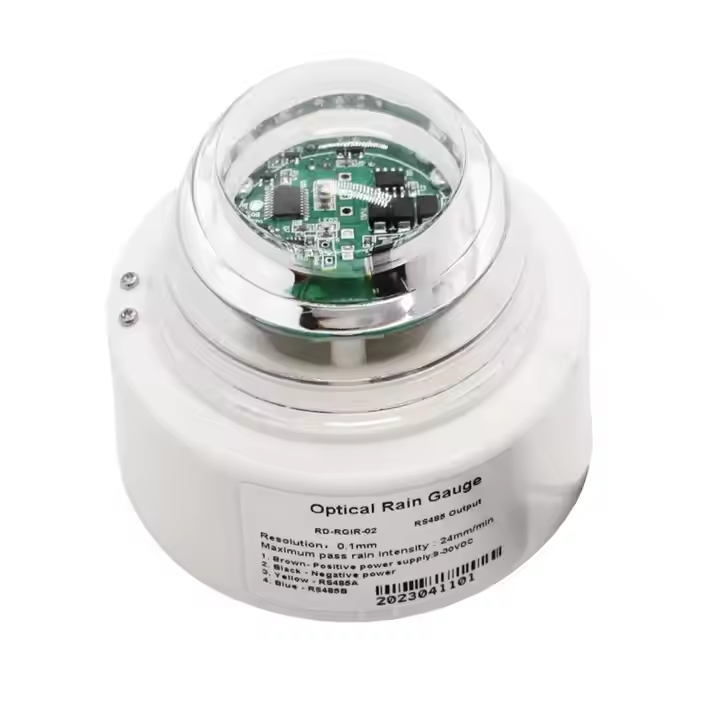19 Mehefin, 2025– Wrth i’r angen am fonitro tywydd cywir a data hydrolegol dyfu, mae mesuryddion glaw optegol yn cael eu mabwysiadu’n eang ar draws sawl sector. Mae’r dyfeisiau uwch hyn yn defnyddio synwyryddion golau i fesur dwyster glawiad gyda chywirdeb uchel, gan gynnig manteision sylweddol dros ddulliau mesur traddodiadol. Dyma rai cymwysiadau nodedig o fesuryddion glaw optegol mewn gwahanol ddiwydiannau.
1. Amaethyddiaeth: Optimeiddio Strategaethau Dyfrhau
Mae ffermwyr wedi dechrau integreiddio mesuryddion glaw optegol i arferion amaethyddol manwl gywir. Er enghraifft, gosododd gwinllan ar raddfa fawr yn Napa Valley, Califfornia, rwydwaith o fesuryddion glaw optegol yn ddiweddar i fonitro glawiad ar eu heiddo. Mae'r dechnoleg hon wedi eu galluogi i optimeiddio amserlenni dyfrhau yn seiliedig ar ddata glawiad amser real, gan leihau gwastraff dŵr a gwella cynnyrch cnydau. Dywedodd perchennog y winllan, “Mae defnyddio mesuryddion glaw optegol wedi ein galluogi i ymateb yn gyflym i amodau tywydd sy'n newid, gan sicrhau bod ein gwinwydd yn derbyn y swm gorau posibl o ddŵr.”
2. Rheoli Llifogydd Trefol
Mae dinasoedd sy'n wynebu heriau gyda rheoli dŵr storm wedi canfod bod mesuryddion glaw optegol yn amhrisiadwy. Yn Houston, Texas, dinas sy'n dueddol o lifogydd, mae'r llywodraeth leol wedi gweithredu system o fesuryddion glaw optegol ledled ardaloedd critigol. Mae'r mesuryddion hyn yn monitro dwyster glaw yn barhaus ac yn caniatáu casglu data amser real. Nododd cyfarwyddwr rheoli llifogydd y ddinas, "Trwy ddefnyddio'r mesuryddion glaw arloesol hyn, gallwn ragweld digwyddiadau llifogydd posibl yn fwy cywir a defnyddio adnoddau'n fwy effeithiol, gan leihau'r effaith ar drigolion."
3. Ymchwil Hydrolegol
Mae prifysgolion a sefydliadau ymchwil hefyd yn defnyddio mesuryddion glaw optegol ar gyfer astudiaethau hydrolegol. Mae Prifysgol Berlin wedi integreiddio rhwydwaith o fesuryddion glaw optegol yn eu hymchwil ar reoli dalgylchoedd ac effeithiau newid hinsawdd. Mae athrawon a myfyrwyr yn defnyddio'r data a gesglir i fodelu symudiad dŵr mewn amrywiol amgylcheddau, gan wella eu dealltwriaeth o ecosystemau. Dywedodd ymchwilydd blaenllaw, “Mae cywirdeb a dibynadwyedd mesuryddion glaw optegol wedi gwella ein prosesau casglu data yn sylweddol, gan ganiatáu inni ddod i gasgliadau mwy cywir yn ein hastudiaethau.”
4. Monitro Tywydd Awyrenneg
Mae'r diwydiant awyrennau wedi mabwysiadu mesuryddion glaw optegol i wella mesurau diogelwch. Mae meysydd awyr bellach yn defnyddio'r mesuryddion hyn i fonitro amodau tywydd yn agos, yn enwedig yn ystod tywydd stormus neu law trwm. Mae gweithrediad diweddar ym Maes Awyr Heathrow wedi darparu data hanfodol sy'n cynorthwyo wrth wneud penderfyniadau ar gyfer gweithrediadau hedfan. Dywedodd llefarydd ar ran y maes awyr, "Mae cael data amser real o fesuryddion glaw optegol yn caniatáu inni reoli gweithrediadau daear yn fwy effeithiol, gan sicrhau diogelwch teithwyr a staff."
5. Cadwraeth Amgylcheddol
Mae asiantaethau amgylcheddol yn defnyddio mesuryddion glaw optegol i fonitro patrymau glawiad a'u heffaith ar ecosystemau lleol. Defnyddiodd astudiaeth ddiweddar yng nghoedwig law'r Amason y dyfeisiau hyn i ddeall dosbarthiad glawiad a'i effaith ar fioamrywiaeth. Llwyddodd ymchwilwyr i gasglu data cydraniad uchel sy'n cynorthwyo ymdrechion cadwraeth. Dywedodd ecolegydd a oedd yn rhan o'r prosiect, “Mae mesuryddion glaw optegol wedi rhoi data hanfodol inni sy'n ein helpu i amddiffyn bioamrywiaeth gyfoethog yr Amason trwy astudio sut mae patrymau glawiad yn effeithio ar wahanol rywogaethau.”
Casgliad
Mae cymwysiadau mesuryddion glaw optegol yn y byd go iawn yn profi i fod yn drawsnewidiol ar draws sectorau amrywiol, o amaethyddiaeth a rheolaeth drefol i ymchwil a diogelwch awyrennau. Wrth i dechnoleg barhau i ddatblygu, disgwylir i weithredu mesuryddion glaw optegol dyfu, gan wella cywirdeb mesur glaw a chyfrannu'n sylweddol at well gwneud penderfyniadau mewn diwydiannau sy'n ddibynnol ar y tywydd.
Am ragor o wybodaeth, cysylltwch â Honde Technology Co., LTD.
Email: info@hondetech.com
Gwefan y cwmni:www.hondetechco.com
Ffôn: +86-15210548582
Amser postio: 19 Mehefin 2025


